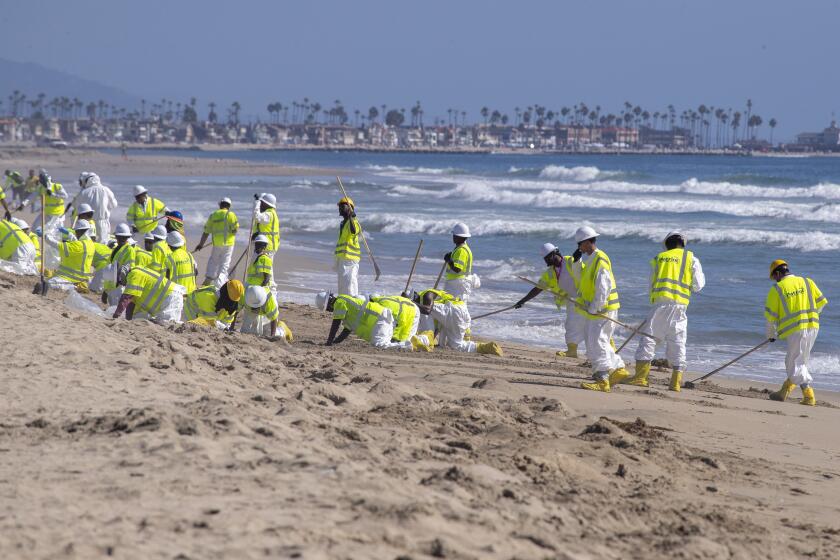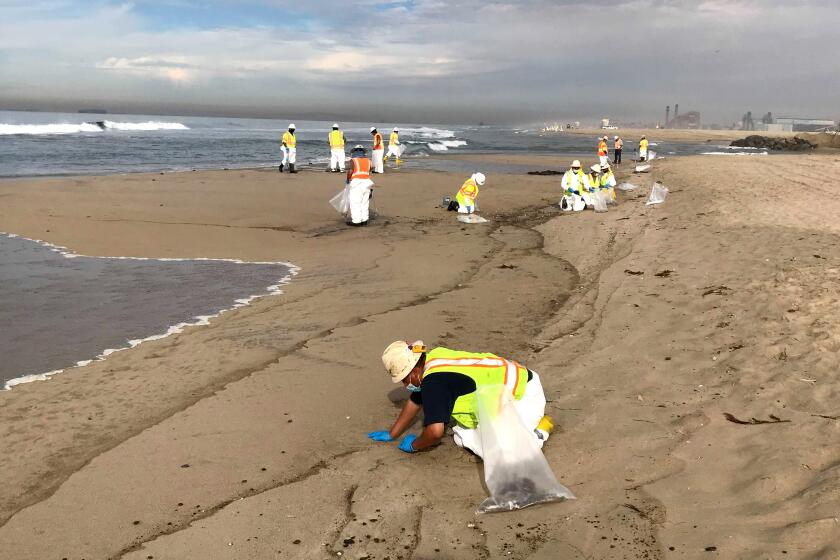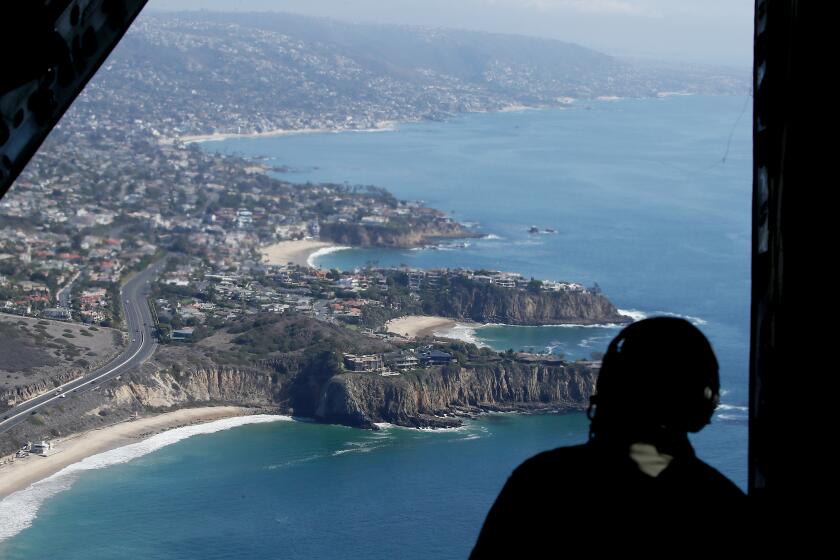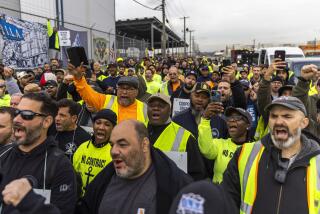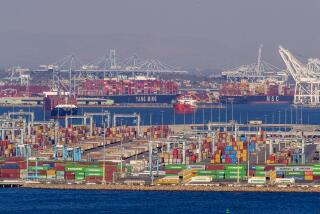How a coast crowded with ships, port gridlock and an anchor may have caused O.C. oil spill
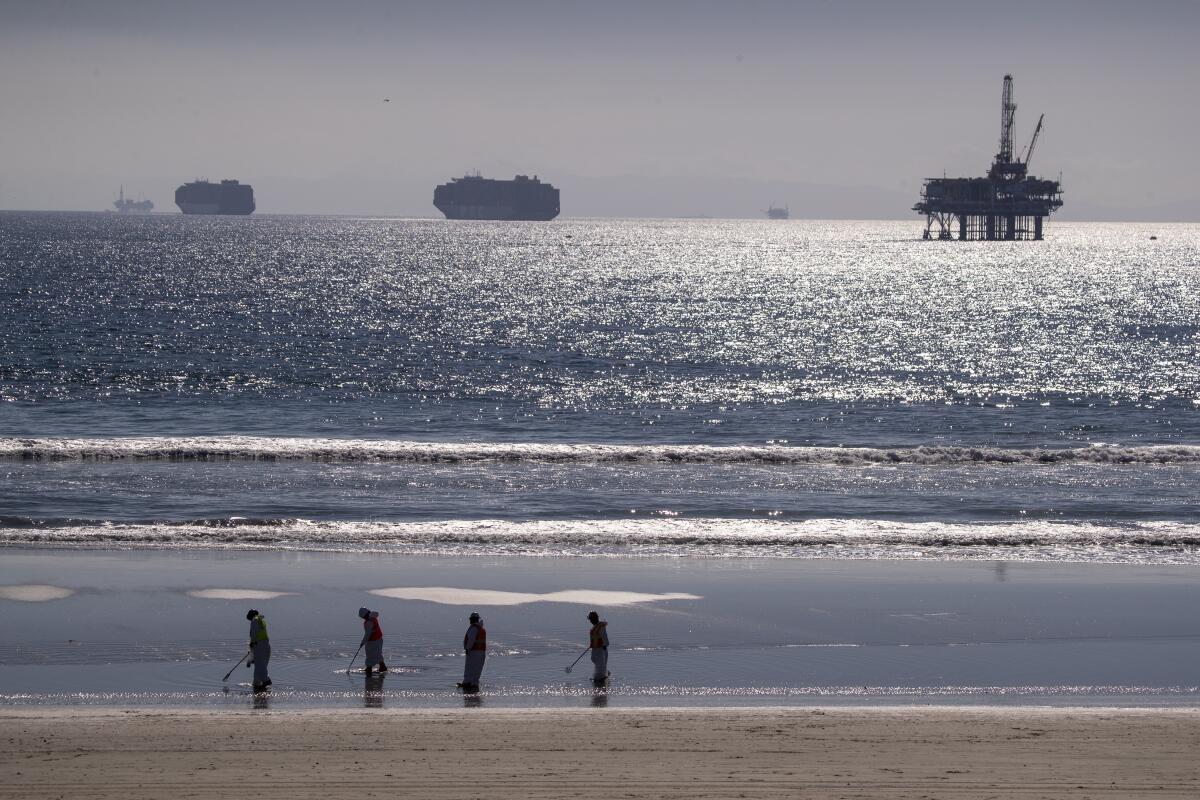
- Share via
In a year that has set records for the number of ships coming and going through the ports of Los Angeles and Long Beach, Friday was not unusual. Winds were light, and the steady movement of traffic at sea was routine.
“I describe it as ‘status quo,’” said Kip Louttit, executive director of the Marine Exchange of Southern California, the agency that directs local maritime traffic.
But the status quo, compared to previous years, was extraordinary, given the heavy concentration of ships waiting offshore to deliver cargo. Container ship traffic has increased fivefold since 2019, and supply chains, affected by production slowdowns and high consumer demand related to the pandemic, are in an unprecedented bottleneck.
A massive oil spill off the Orange County coast has fouled beaches and killed birds and marine life
With Los Angeles and Long Beach harbors at near capacity, container ships and oil tankers have had to drop massive anchors in designated sites that place them near oil platforms and an undersea infrastructure of oil lines, sewage treatment pipes and communications equipment.
The combination of oil production and global shipping in the same coastal area is now at the center of an investigation into the cause of a massive oil spill that sent crude onto Orange County beaches and sensitive wetland areas.
The U.S. Coast Guard is looking at the possibility that the crush of shipping traffic came into violent contact with this network of undersea infrastructure and triggered a spill that sent an estimated 144,000 gallons of oil into the ocean.
The offshore waters along the Orange and Los Angeles county coasts are teeming with cargo ships waiting to get into the ports of L.A. and Long Beach.
On Tuesday, diver reports and footage from remotely operated submarines showed that a 4,000-foot section of a nearly 18-mile oil pipeline had been displaced approximately 105 feet and had a 13-inch split along its length, according to the Joint Unified Command, which is overseeing the investigation.
The displacement, federal sources said, is best explained by a ship’s anchor dragging across the ocean floor and hooking into the pipeline. There were multiple large cargo vessels in the immediate area of the leak before the oil was spotted.
A final determination for the cause of the spill may take months, but Coast Guard investigators have come up with no other explanation, federal sources said.
Martyn Willsher, president and chief executive of the pipeline operator’s parent, Amplify Energy Corp., described the force as pulling the pipe in an almost “semicircle.”
“The pipeline has essentially been pulled like a bowstring,” he said.
Louttit said anchors typically weigh 30 tons and can bury themselves up to 10 feet in offshore sediment. Anchor dragging is rare, he added, and typically occurs in winds over 35 knots.
“We haven’t had one drag since last winter,” he said. “We haven’t had that much wind in months.”
Some wonder whether the damage to the pipeline took place recently or if it happened months ago, and corrosion finally opened a rupture.
Despite high temperatures Friday, winds were light, and the sky was clear. No marine hazards had been forecast.
While an accident like this would be unusual, given the history of ships safely anchoring in the harbors, traffic has dramatically increased since July.
Last month, the Marine Exchange reported the arrival of 414 vessels to the ports, compared with 344 in 2020. The backup has been pronounced, said Louttit, but he is reluctant to call it a traffic jam.
“The anchorages are preplanned, and standards of care for anchoring the ships are always in place,” he said.
Ships entering the harbor can be sent to one of 60 locations, identified by the Coast Guard and Marine Exchange, to safely drop their anchors, said Louttit. On Friday afternoon, nearly 55 of those sites were occupied, a number that has remained consistent over the last few months.
The sites are away from pipelines, sewage outfalls and underwater communication lines that snake across the ocean floor. Ships are positioned in water ranging in depth from 60 feet to 210 feet, which is the draft of the largest vessel, an oil tanker, and the maximum amount of anchor chain carried by ships. Southern California’s marine shelf, with its steep drop-off, keeps vessels close to shore.
Federal regulators said the location of the spill may be about five miles offshore, where the water is about 98 feet deep.
Louttit describes a methodical and well-orchestrated movement of ships in their approach to Southern California. Container ships and oil tankers, waiting for a berth, are assigned a place to anchor in the roadstead off Long Beach and Huntington Harbor.
A major oil spill off the coast of Huntington Beach, Calif., washed up on nearby Orange County beaches, killing fish and birds and threatening local wetlands.
An overflow section off Huntington Beach, located between a series of oil platforms, was also being used, but ships have not been assigned to that area since the oil spill.
Much like an air traffic control center, the Marine Exchange organizes the flow of vessels coming in and out of the ports of Los Angeles and Long Beach. Their work, said Louttit, begins as soon as a ship comes within four days, or 800 miles, of the ports.
At that point, every commercial ship or yacht weighing more than 300 tons must submit to the Coast Guard an advance notice of arrival that reviews the vessel’s manifest, for security purposes.
Under normal conditions, ships are assigned an anchorage if their berth is not available, but in the last few months, ships that come within 25 miles of the ports are assigned to a “drift area” either between Catalina Island and the Palos Verdes Peninsula or off Dana Point. They then turn off the engines that drive the propellers and drift in the current and wind, with occasional repositioning.
When there is an opening for them in the anchorage, they proceed to a specific latitude and longitude, where they drop their anchor. The Marine Exchange can direct them either to an area close to the Long Beach breakwater or down the coast off Huntington Beach.
Most ships are 200 yards to 400 yards long, and the Marine Exchange, which stays in touch with the captain during anchoring operations, gives ships a 100-yard leeway in hitting their coordinate.
In the back of the plane with the cargo door open, two flight mechanics looked for oil sheens in the dark teal ocean while reporters on board watched.
Ships typically prefer to be closer to the port, where they can more easily be reached by water taxis for the purpose of changing crews, picking up groceries or running repairs.
Once a berth is open, the ship is given a specific time to arrive at a designated area closer to the port and rendezvous with the port pilot, who, with the help of tugboats, guides the ship in, where it is offloaded by longshoremen.
While traffic is circulating throughout the harbor 24/7, most ships start moving toward their assigned berths at 4 a.m., approximately four hours before the longshoremen start the morning shift.
In the days ahead, studying ship movements — down to the hour — will become critical to identifying the vessel responsible for the oil spill.
Pipeline expert Richard Kuprewicz expects investigators to remove the damaged pipeline, then begin a metallurgical examination of the steel.
“When did the strain occur?” he asked. “Days before? Or did something in its operation cause it to rupture Friday night? The forensic science is sophisticated, and they should be able to tell if the damage was delayed or immediate.”
Times staff writers Andrew J. Campa, Ruben Vives, Laura J. Nelson and Hannah Fry contributed to this report.
More to Read
Sign up for Essential California
The most important California stories and recommendations in your inbox every morning.
You may occasionally receive promotional content from the Los Angeles Times.
